How to lead train a dog? A well-trained dog is thrilling. Training your dog for basic obedience helps to make your bond more strong.
In this blog, we are going to explore the step-by-step guide to lead train a dog. Training creates confidence, trust, and mutual understanding, so without waiting anymore let’s begin.
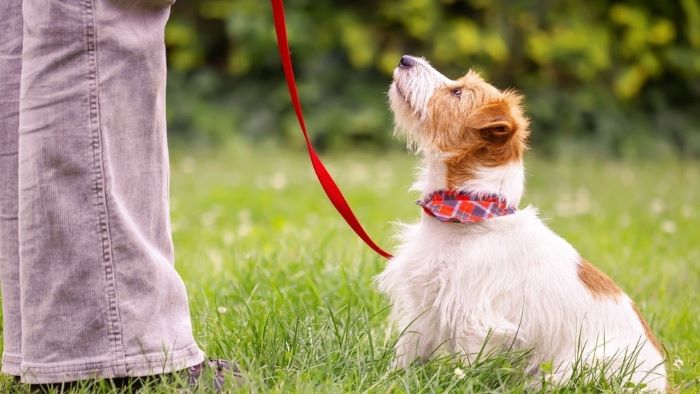
How to Lead Train a Dog?
Different breeds have different characteristics and temperaments. Understanding these is important for effective training. Dogs, like people, vary in their adaptability to new environments and situations.
Some dogs thrive on change, while others prefer routine. High-energy dogs may need more vigorous exercises to stay engaged, while calmer dogs may appreciate a more relaxed approach. So, let’s explore this step-by-step lead training guide:
Step- 1: Supplies Needed
Here are the supplies you’ll need to lead your train:
- The leash and collar or harness as per your dog’s size and breed. A small dog may need a lighter leash, while a larger dog may need a sturdier one. Consider good quality materials like Nylon, which is lightweight, while leather offers durability.
- Use treats that your dog finds irresistible. These high-value treats become powerful motivators during training. Keep treats small to avoid overfeeding.
- A clicker is a small, handheld device that makes a different sound.
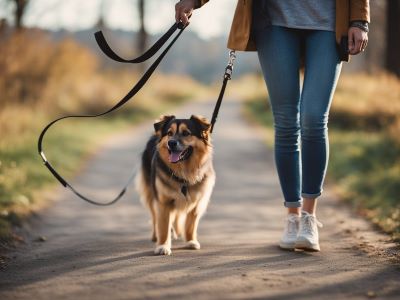
Step- 2: Clearing the Basics
Basics are important. Use the same commands for specific actions consistently, so your dog understands what is expected. Consistency builds clarity, reducing confusion and boosting learning. Here are some basic commands:
- Sit: Start with a treat at your dog’s nose and raise it, encouraging them to sit. Reward and praise when they do.
- Stay: Begin with a short duration and gradually increase it. Use a hand signal and verbal cue to reinforce the command.
- Come: Use a happy tone and crouch down to your dog’s level, calling them to come. Reward and celebrate when they do.
Step- 3: Training Sessions
Keep it short. Puppies and new dogs do best with 5-10 minute sessions. Short sessions prevent them from getting overwhelmed. Smile and use an upbeat tone. Dogs respond to your enthusiasm. Celebrate when they get something right.
Make it fun. Incorporate toys that challenge their brains and bodies: puzzle toys, treat toys, fetch, and agility activities. This keeps them engaged. Add movement.
Set up simple obstacle courses or get agility equipment so they can burn mental and physical energy. This boosts their coordination and confidence.
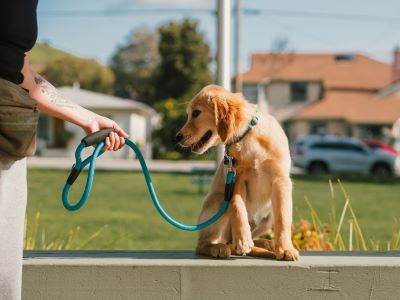
Keep it simple. Break training into small, achievable tasks. Dogs learn best when you build up gradually using positive reinforcement like praise and treats.
Step- 4: Socialization
Here is how you can help your dog to socialize in their life:
A) People
Introduce your dog to different types of people: young, old, men, women, people in hats or with beards. Start slowly and reward calm behaviour. Teach your dog not to jump when saying hi.
Reward four paws on the floor with treats and praise. Slowly allow your dog to approach new people. Let them sniff the person, then reward calmness. Make sure your dog has a positive experience. Give treats and toys to create a fun, safe atmosphere.
Go slowly, reward calm behaviour, and keep introductions feeling like a happy game. Be patient and positive, this makes training enjoyable for you and your dog!
B) Animals
Introduce your dog to other calm, friendly dogs. Start slow, reward relaxed behaviour. Watch for signs of anxiety or aggression. Create distance if needed and work gradually.
Allow light, polite play with other dogs. Reward gentle manners, and interrupt overly rough play. Consistently praise and treat good behaviour. This links social success with rewards.
Controlled, positive introductions to dogs, cats and other animals when young helps prevent fear and aggression later on. Go at your dog’s pace, reward friendly manners, and intervene if things get too rowdy.
C) Places
Take your dog to parks, trails, and busy sidewalks. Make it fun with praise and treats. Use treats and toys to encourage confidence with new surfaces, noises, and objects.
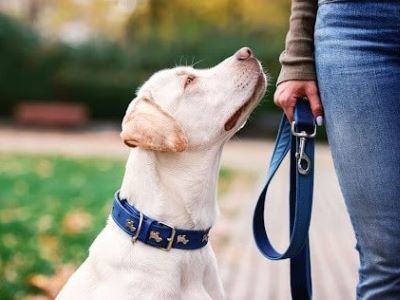
Gradually introduce new settings. Go at their pace so they don’t get overwhelmed. Smile, praise calm behaviour, and use high-value treats. This links new places with good things.
Exposing your dog to variety while young, new sights, sounds, and places: raises their confidence and adaptability. Make adventures fun! Reward bravery, go slowly, and end on a positive note.
Step- 5: Positive Reinforcement
Give them triple threat: Treats, Praise, and Play. Use tasty treats to motivate your dog to obey commands like sit, stay, and come. Vary treats to keep things interesting.
“Cheer “Good dog!” when they do what you ask. Your happy tone and attention is a big reward. A game of fetch, tug or chase makes for a fun reward for training success”, says Erika Lessa at PetMD.
If they misbehave, calmly redirect them to what you want them to do, then reward them. Don’t yell or scold. This creates anxiety and fear, disrupting learning.
Positive training methods using rewards like treats, praise and play make lessons enjoyable. Stay patient, and focus on rewards for good behaviour rather than scolding bad. This approach boosts your dog’s confidence, strengthening your bond.
Benefits of Leash Training
With different steps, let’s see what are the benefits of leash training your dog:
Safety First
Proper leash training teaches your dog not to pull, ensuring they don’t dart into traffic or other hazardous situations during walks.
Keeping your dog from lunging towards cars, bikes, or other dogs prevents tragic accidents and injuries. Leash control allows you to guide your pup safely past any dangers.
Avoiding Conflicts
Dogs tend to view loose dogs as a threat.
Leash training provides control if another dog approaches, letting you create distance and avoiding aggressive interactions that could turn dangerous. This keeps both dogs safe.
Stronger Bond
Leash training backs the leadership role between owner and pet.
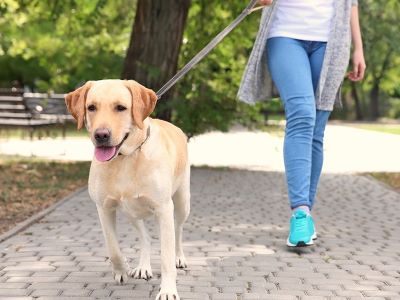
As your dog learns not to pull and to follow commands, mutual trust and respect are built. Good leash manners require teamwork and bring you closer together.
More Freedom
Once your dog reliably walks without pulling, new opportunities open up: longer walks, hikes, outdoor cafes, travel and more.
The world becomes your oyster when you can bring them along without the leash getting in the way.
Training Troubles
Here are some tips to chase away the training troubles[1]:
- Use treats and fun sounds to reinforce focus commands like “watch me” or “leave it“. This builds attention amid distractions.
- Reward slack leashes, stop when they pull. Be patient and consistent, this takes practice.
- Identify what triggers anxious or aggressive reactions, then work to gradually make those things positive. Shower your pup with praise and treats when they get something right. This boosts confidence.
- Keep mixing up activities to engage their brains and bodies. Training is a lifelong journey for dogs and owners. Be patient with mess-ups by redirecting unwanted behaviours. Avoid yelling or scolding.
- Let the leash guide your dog by showing them where you want them to be. This establishes you as a pack leader. Every dog is different. Adjust techniques to suit your dog’s unique personality.
FAQs
❔How Long Does It Take To Leash Train a Dog?
“Puppies are really easy and can probably be fully leash-trained in a month,” Novack says, but also cautions to be wary of the ‘teenage’ phase opens in a new tab that dogs go through at around nine months old. “When they hit adolescence, they’re going to pretend they’ve never learned anything.
❔How to Lead Train a Dog?
1. Start in a small, quiet space indoors. Teach this behaviour indoors, in a small, quiet room. 2. Introduce the harness and leash, with treats! 3 Take a small step in any direction. 4. Practice moving in different directions. 5. Start feeding treats only on one side.
❔Is It Too Late to Leash-Train My Dog?
It’s best to train your dog early on to prevent these problems, but it’s never too late. The key to success is reward-based dog training, which is the most effective and humane way to teach your dog.
❔What Is the Best Age to Leash Train a Dog?
You can start leash training your puppy at 7-8 weeks old. But remember that puppies have very short attention spans and will require a lot of patience. The ideal age is about 10 weeks old because they understand routine by this age and follow basic commands.
❔How Do You Teach a Dog Its Name?
Do: Wait until your dog is not looking at you and then say the name in a very bright and happy tone. As soon as your dog turns to look at you, mark this with a clicker or a word to let the dog know this is the right reaction, a word like “yes” or “good,” and then immediately give your dog a treat.
Conclusion
In conclusion “How to lead train a dog?” Leash training helps your dog to adjust to various parts of life easily. Training your dog strengthens the bond between you and your dog.
Keep mixing up physical and mental challenges over your dog’s lifetime. This maintains their curiosity and enthusiasm.
Stay consistent and reward your dog with treats and praise, “Good Boy” goes the long way! Here is to a happy and healthy leash training.
Reference:
- Donovan, L. (2023b, July 17). How to teach a puppy to walk on a leash. American Kennel Club.



